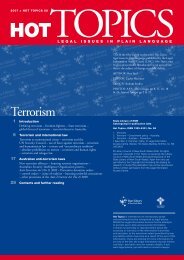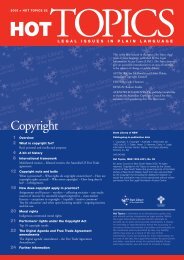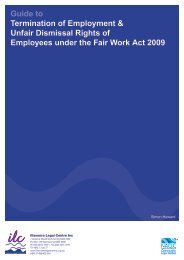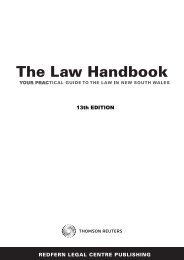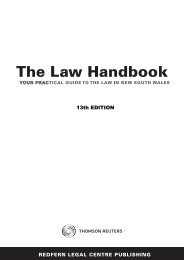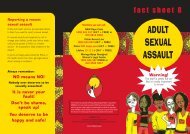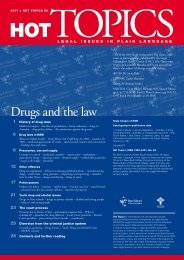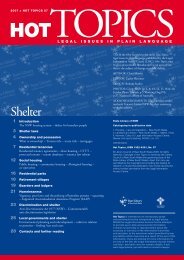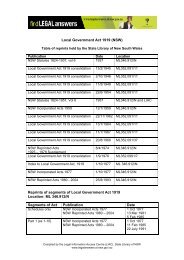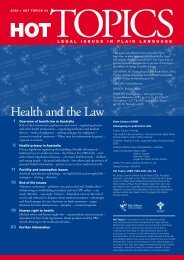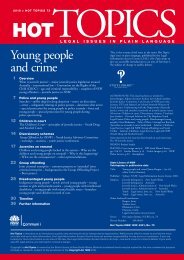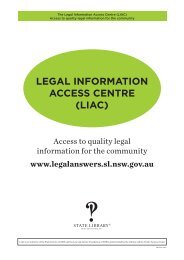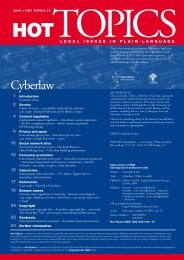Prisoners - Legal Information Access Centre - NSW Government
Prisoners - Legal Information Access Centre - NSW Government
Prisoners - Legal Information Access Centre - NSW Government
Create successful ePaper yourself
Turn your PDF publications into a flip-book with our unique Google optimized e-Paper software.
approximately one-third of males and two-thirds of<br />
females were Hepatitis C positive;<br />
> approximately one-third of males and half the females<br />
had been assessed or treated for mental illness by a<br />
psychiatrist or psychologist at some time;<br />
> 13% of inmates have an intellectual disability;<br />
> 16% of inmates have been sexually abused before the<br />
age of 16;<br />
> 21% of inmates have attempted suicide;<br />
> 40% of inmates meet the diagnosis of personality<br />
disorder.<br />
sOciO-ecOnOmic sTATus<br />
The Final Report quoted <strong>NSW</strong> Department of Corrective<br />
Services figures which showed:<br />
> 60% of inmates are not functionally literate or<br />
numerate;<br />
> 44% of inmates are long term unemployed;<br />
> 60% of inmates did not complete year 10 schooling;<br />
> 64% of inmates have no stable family;<br />
> many inmates have had contact with the Department<br />
of Community Services, with a high proportion of<br />
those being state wards. 15<br />
The Final Report went on to note that research by<br />
Professor Tony Vinson found that in <strong>NSW</strong> most offenders<br />
were drawn from the ‘top 30’ most disadvantaged<br />
neighbourhoods which accounted for:<br />
> four and a quarter times their share of child abuse;<br />
> three and a quarter times their share of emergency<br />
assistance;<br />
> three times their share of court convictions and long<br />
term unemployment;<br />
> twice their share of low income households;<br />
> a little under one and a half times their share of school<br />
leavers before 15 years. 16<br />
In terms of their health and socio-economic status<br />
prisoners are disproportionately affected by drug and<br />
alcohol problems, intellectual disability, illiteracy and<br />
innumeracy, low educational attainment, unemployment,<br />
having been the victim of child sexual assault, being<br />
state wards, and having weak or no family ties.<br />
Offences cOmmiTTed<br />
In 2007 across Australia, the most common offences<br />
(sentenced and unsentenced) were:<br />
> acts intended to cause injury (various forms of assault)<br />
(19%);<br />
> sexual assault (11%);<br />
> unlawful entry with intent (break and enter) (12%);<br />
> homicide (10%);<br />
> illicit drug offences (10%);<br />
> robbery and extortion (9%).<br />
In terms of the sentences prisoners were serving at the<br />
time of the survey:<br />
> 5% of all sentenced prisoners were serving a life<br />
sentence or other indeterminate sentence;<br />
> 21% were serving from 5-10 years;<br />
> 23% were serving from 2-5 years;<br />
> 34% were serving less than two years;<br />
> the median expected time to serve was 1.8 years. 17<br />
Note: This survey is of prisoners on one day so that <br />
it is more likely to catch long term prisoners on more <br />
serious offences. Examining total prisoners in Australian <br />
prisons over the course of a year would find many more <br />
short-term prisoners serving sentences for less serious <br />
offences such as public order offences and drunkenness. <br />
This would be even more the case if it included those <br />
being held in police custody as distinct from prisons.<br />
For receptions in <strong>NSW</strong> in 2001, 63% of receptions <br />
(5011 of the total 8005 receptions) were of prisoners <br />
serving less than six months imprisonment. 18<br />
In 2000:<br />
> 7.2% of sentenced prisoners received in that year were <br />
serving sentences of two years and over; 19<br />
> 10% were serving 1-2 years;<br />
> 24.7% were serving 3-6 months;<br />
> 19.8% were serving 6-12 months;<br />
> 37.8% were serving less than 3 months.<br />
The <strong>NSW</strong> Legislative Council Select Committee<br />
concluded:<br />
the prison population consists of men and<br />
women who are on average of lower socioeconomic<br />
status, poorer health and lower levels<br />
of education than the rest of the population.<br />
indigenous men and women and those with an<br />
intellectual disability or a mental illness are<br />
significantly over represented. the average<br />
age of the inmate population is increasing.<br />
although significant numbers of inmates have<br />
been sentenced for serious offences and are<br />
in maximum security classified institutions,<br />
the majority of prisoners who pass through<br />
the system serve sentences of less than six<br />
months and are in minimum security or serving<br />
periodic detention. almost a quarter of the prison<br />
population are awaiting sentence. 20<br />
15. <strong>NSW</strong> Legislative Council (see Note 10) at p 20.<br />
16. As above, quoting Tony Vinson, Unequal in Life: The Distribution of Social Disadvantage in Victoria and <strong>NSW</strong> (1999) Jesuit Social Services:<br />
Melbourne, available online at http://old.jss.org.au/research/pdfs/unequal_full_life.pdf<br />
17. Australian Bureau of Statistics, <strong>Prisoners</strong> in Australia 2007, (2008) 4517.<br />
18. <strong>NSW</strong> Legislative Council (see Note 10) at p 110.<br />
19. <strong>NSW</strong> Legislative Council (see Note 10) at p 29.<br />
20. <strong>NSW</strong> Legislative Council (see Note 10) at p 32.<br />
4<br />
HOT TOPICS 67 > <strong>Prisoners</strong>



